buckle MITSUBISHI ECLIPSE CROSS 2020 Owner's Manual (in English)
[x] Cancel search | Manufacturer: MITSUBISHI, Model Year: 2020, Model line: ECLIPSE CROSS, Model: MITSUBISHI ECLIPSE CROSS 2020Pages: 427, PDF Size: 78.05 MB
Page 35 of 427
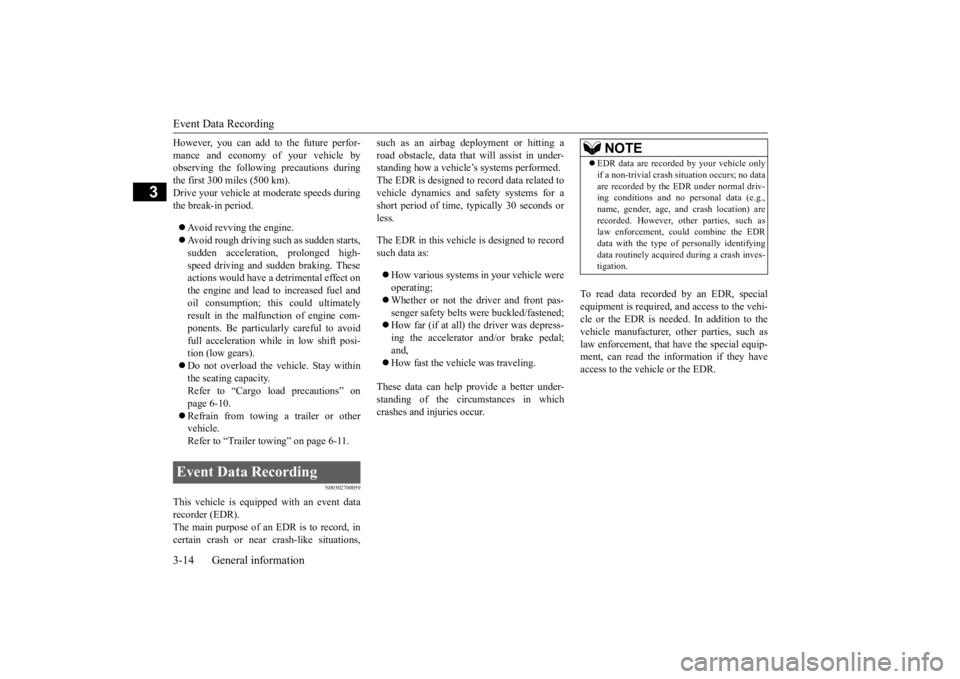
Event Data Recording 3-14 General information
3
However, you can add to the future perfor- mance and economy of your vehicle by observing the follow
ing precautions during
the first 300 miles (500 km).Drive your vehicle at moderate speeds during the break-in period. Avoid revving the engine. Avoid rough driving such as sudden starts, sudden acceleration, prolonged high- speed driving and sudden braking. These actions would have a detrimental effect onthe engine and lead to increased fuel andoil consumption; this could ultimately result in the malfunction of engine com- ponents. Be particularly careful to avoidfull acceleration while in low shift posi- tion (low gears). Do not overload the vehicle. Stay within the seating capacity. Refer to “Cargo load precautions” on page 6-10. Refrain from towing a trailer or other vehicle. Refer to “Trailer towing” on page 6-11.
N00302700059
This vehicle is equipped with an event datarecorder (EDR).The main purpose of an EDR is to record, in certain crash or near crash-like situations,
such as an airbag deployment or hitting a road obstacle, data that will assist in under- standing how a vehicle’s systems performed. The EDR is designed to record data related tovehicle dynamics and safety systems for a short period of time, typically 30 seconds or less. The EDR in this vehicle is designed to record such data as: How various systems in your vehicle were operating; Whether or not the driver and front pas- senger safety belts were buckled/fastened; How far (if at all) the driver was depress- ing the accelerator and/or brake pedal; and, How fast the vehicle was traveling.
These data can help provide a better under- standing of the circumstances in which crashes and injuries occur.
To read data recorded by an EDR, special equipment is required, and access to the vehi- cle or the EDR is needed. In addition to the vehicle manufacturer, other parties, such aslaw enforcement, that have the special equip- ment, can read the information if they have access to the vehicle or the EDR.
Event Data Recording
NOTE
EDR data are recorded by your vehicle only if a non-trivial crash situation occurs; no data are recorded by the EDR under normal driv- ing conditions and no personal data (e.g., name, gender, age, and crash location) arerecorded. However, other parties, such as law enforcement, could combine the EDR data with the type of personally identifyingdata routinely acquired during a crash inves- tigation.
BK0277700US.bo
ok 14 ページ 2019年3月8日 金曜日 午前9時23分
Page 48 of 427
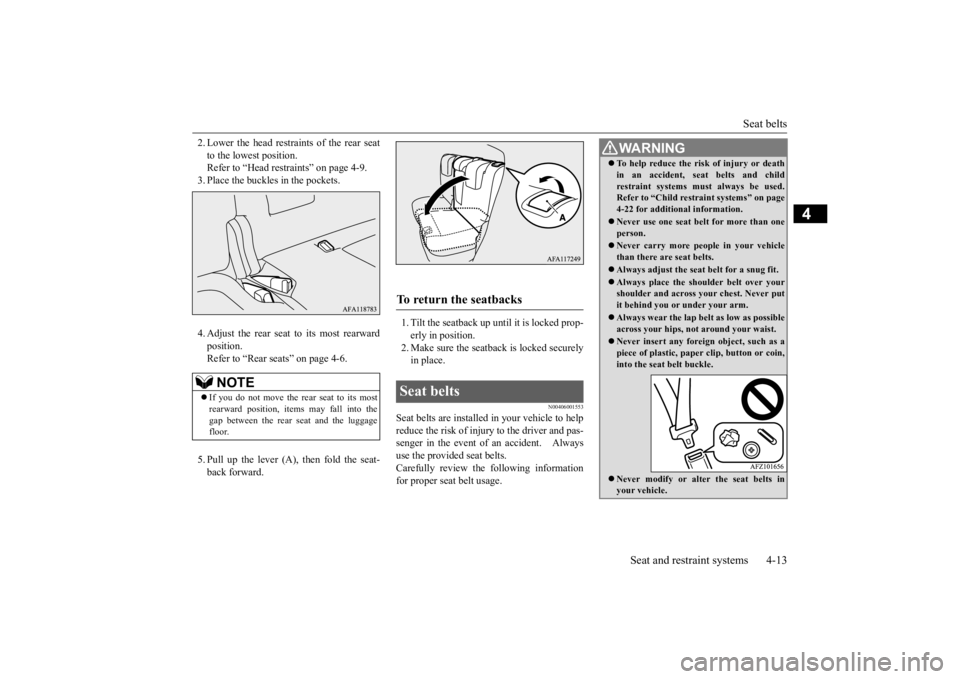
Seat belts
Seat and restraint systems 4-13
4
2. Lower the head restraints of the rear seat to the lowest position. Refer to “Head restraints” on page 4-9. 3. Place the buckles in the pockets. 4. Adjust the rear seat to its most rearward position. Refer to “Rear seats” on page 4-6. 5. Pull up the lever (A), then fold the seat- back forward.
1. Tilt the seatback up until it is locked prop- erly in position.2. Make sure the seatback is locked securely in place.
N00406001553
Seat belts are installed in your vehicle to help reduce the risk of injury to the driver and pas- senger in the event of an accident. Always use the provided seat belts.Carefully review the following information for proper seat belt usage.
NOTE
If you do not move the rear seat to its most rearward position, items may fall into the gap between the rear seat and the luggagefloor.
To return the seatbacks Seat belts
WA R N I N G To help reduce the risk of injury or death in an accident, seat belts and child restraint systems must always be used. Refer to “Child restraint systems” on page 4-22 for additional information. Never use one seat belt for more than one person. Never carry more people in your vehicle than there are seat belts. Always adjust the seat belt for a snug fit.Always place the shoulder belt over your shoulder and across your chest. Never put it behind you or under your arm. Always wear the lap belt as low as possible across your hips, not around your waist. Never insert any foreign object, such as a piece of plastic, paper clip, button or coin,into the seat belt buckle. Never modify or alter the seat belts in your vehicle.
BK0277700US.bo
ok 13 ページ 2019年3月8日 金曜日 午前9時23分
Page 50 of 427
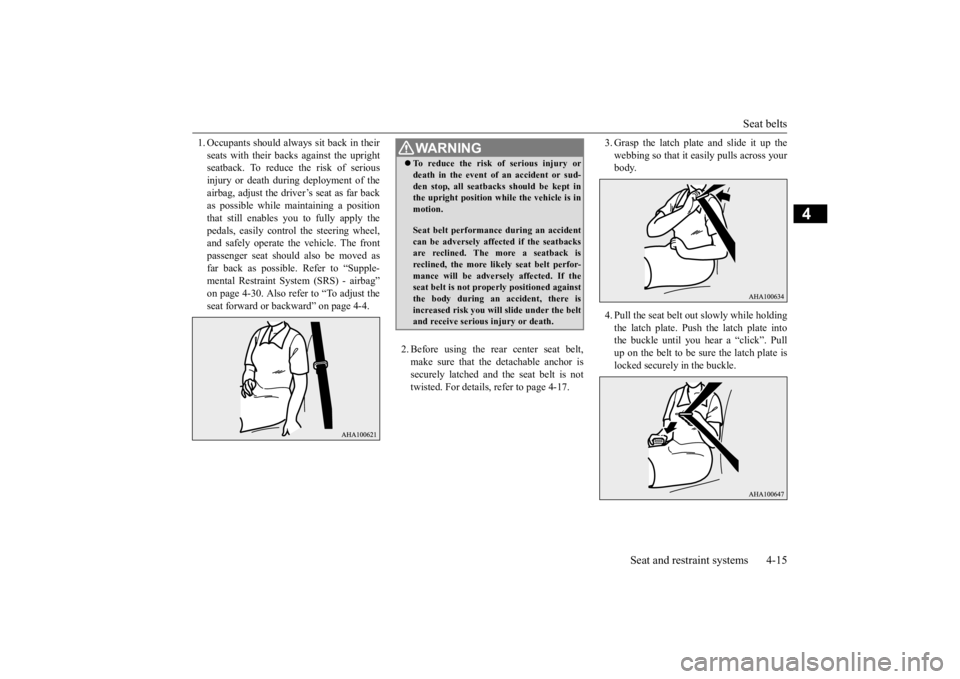
Seat belts
Seat and restraint systems 4-15
4
1. Occupants should always sit back in their seats with their backs against the upright seatback. To reduce the risk of serious injury or death during deployment of theairbag, adjust the driver’s seat as far back as possible while maintaining a position that still enables you to fully apply thepedals, easily control the steering wheel, and safely operate the vehicle. The front passenger seat should also be moved asfar back as possible. Refer to “Supple-mental Restraint System (SRS) - airbag” on page 4-30. Also refer to “To adjust the seat forward or backward” on page 4-4.
2. Before using the rear center seat belt, make sure that the detachable anchor is securely latched and the seat belt is nottwisted. For details, refer to page 4-17.
3. Grasp the latch plate and slide it up the webbing so that it easily pulls across your body. 4. Pull the seat belt out slowly while holding the latch plate. Push the latch plate into the buckle until you hear a “click”. Pull up on the belt to be sure the latch plate islocked securely in the buckle.
WA R N I N G To reduce the risk of serious injury or death in the event of an accident or sud- den stop, all seatbacks should be kept in the upright position while the vehicle is in motion. Seat belt performance during an accident can be adversely affected if the seatbacksare reclined. The more a seatback is reclined, the more likely seat belt perfor- mance will be adversely affected. If theseat belt is not properly positioned against the body during an accident, there is increased risk you will slide under the beltand receive serious injury or death.
BK0277700US.bo
ok 15 ページ 2019年3月8日 金曜日 午前9時23分
Page 51 of 427

Seat belts 4-16 Seat and restraint systems
4
5. The lap part of the belt must always be worn low and snug across the hips. Pull up on the shoulder portion of the belt totake up any slack in the lap belt.
6. To release the belt, press the button on the buckle and allow the belt to retract. If the belt does not retract smoothly, pull it out and check for kinks or twists in thewebbing. Then make sure it remains untwisted as it retracts.
NOTE
If the seat belt locks up and cannot be pulled out, pull it once with force and let it retract all the way. Then, pull the belt out slowly once again.
NOTE
With the exception of the seat belt for the driver, the seat belts in all other seating posi- tions are equipped with an Automatic Lock- ing Retractor (ALR) function. If you pull the seat belt fully out of the retractor, the retrac-tor will switch to its ALR child restraint installation function (see page 4-27). When the ALR function has been activated,the seat belt will only retract. If this happens, let the belt fully retract, then pull the seat belt back out, repeating steps 1 through 4.WA R N I N G Be sure the lap belt portion fits snugly and is worn as low as possible across the hips, not around the waist. Failure to follow thisinstruction will increase the risk of serious injury or death in the
event of an accident.
Be sure the seat belt webbing is not twisted when worn. Twisted webbing may adversely affect seat belt performance.
NOTE
If the seat belt (A) or ring (B) becomes dirty, the belt may not retract smoothly. If the seat belt and ring are dirty, clean them with amild soap or detergent solution.
BK0277700US.bo
ok 16 ページ 2019年3月8日 金曜日 午前9時23分
Page 53 of 427
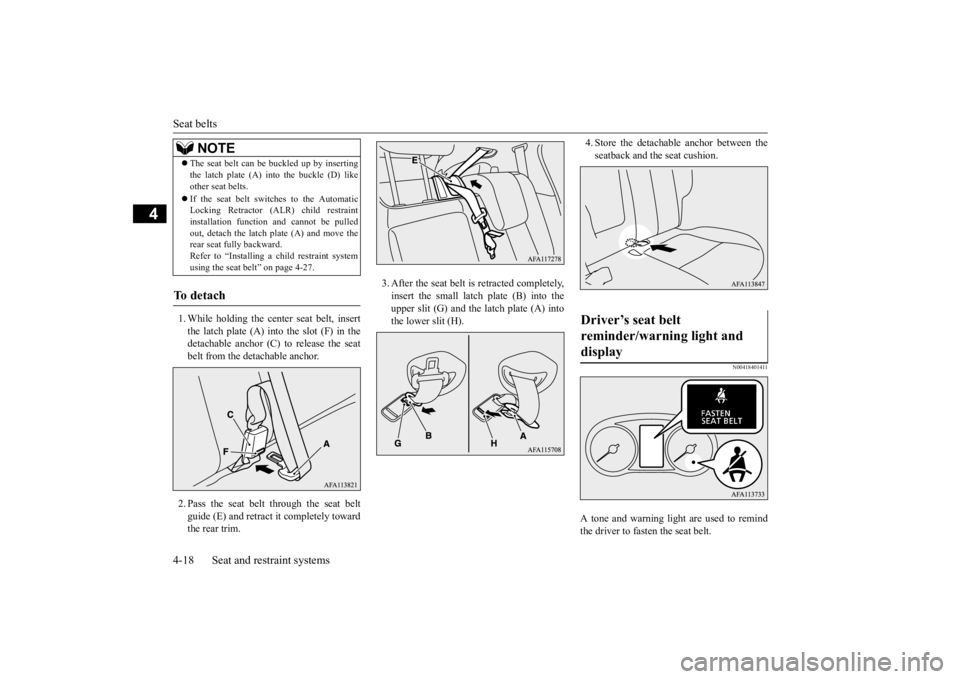
Seat belts 4-18 Seat and restraint systems
4
1. While holding the center seat belt, insert the latch plate (A) into the slot (F) in the detachable anchor (C) to release the seatbelt from the detachable anchor. 2. Pass the seat belt through the seat belt guide (E) and retract it completely toward the rear trim.
3. After the seat belt is retracted completely, insert the small latch plate (B) into theupper slit (G) and the latch plate (A) into the lower slit (H).
4. Store the detachable anchor between the seatback and the seat cushion.
N00418401411
A tone and warning light are used to remind the driver to fasten the seat belt.
The seat belt can be buckled up by inserting the latch plate (A) into the buckle (D) like other seat belts. If the seat belt switches to the Automatic Locking Retractor (ALR) child restraint installation function and cannot be pulled out, detach the latch plate (A) and move therear seat fully backward. Refer to “Installing a child restraint system using the seat belt” on page 4-27.
To d e t a c h
NOTE
Driver’s seat belt reminder/warning light and display
BK0277700US.bo
ok 18 ページ 2019年3月8日 金曜日 午前9時23分
Page 56 of 427
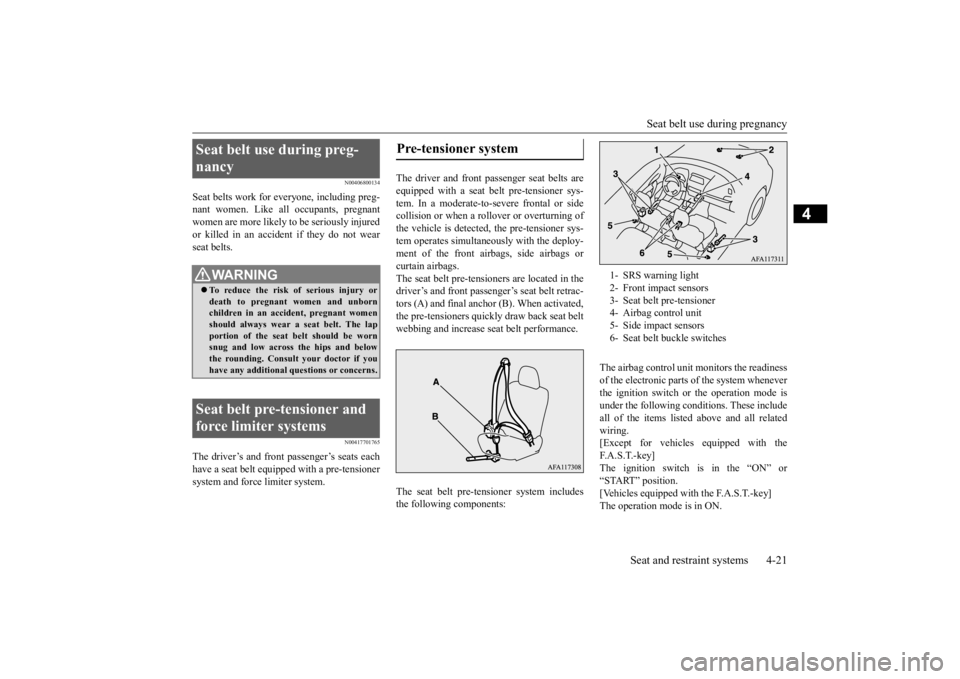
Seat belt use during pregnancy
Seat and restraint systems 4-21
4
N00406800134
Seat belts work for ev
eryone, including preg-
nant women. Like all occupants, pregnantwomen are more likely to be seriously injured or killed in an accident if they do not wear seat belts.
N00417701765
The driver’s and front passenger’s seats eachhave a seat belt equipped with a pre-tensioner system and force limiter system.
The driver and front passenger seat belts are equipped with a seat belt pre-tensioner sys-tem. In a moderate-to-severe frontal or side collision or when a rollover or overturning of the vehicle is detected, the pre-tensioner sys-tem operates simultaneously with the deploy- ment of the front airbags, side airbags or curtain airbags.The seat belt pre-tensioners are located in thedriver’s and front passenger’s seat belt retrac- tors (A) and final anchor (B). When activated, the pre-tensioners quickly draw back seat beltwebbing and increase seat belt performance. The seat belt pre-tensioner system includes the following components:
The airbag control unit monitors the readiness of the electronic parts of the system wheneverthe ignition switch or the operation mode is under the following conditions. These include all of the items listed above and all relatedwiring. [Except for vehicles equipped with the F. A . S . T. - k e y ]The ignition switch is in the “ON” or “START” position. [Vehicles equipped with the F.A.S.T.-key]The operation mode is in ON.
Seat belt use during preg- nancy
WA R N I N G To reduce the risk of serious injury or death to pregnant women and unbornchildren in an accident, pregnant women should always wear a seat belt. The lap portion of the seat belt should be wornsnug and low across the hips and below the rounding. Consult your doctor if you have any additional questions or concerns.
Seat belt pre-tensioner and force limiter systems
Pre-tensioner system
1- SRS warning light 2- Front impact sensors 3- Seat belt pre-tensioner 4- Airbag control unit5- Side impact sensors 6- Seat belt buckle switches
BK0277700US.bo
ok 21 ページ 2019年3月8日 金曜日 午前9時23分
Page 60 of 427
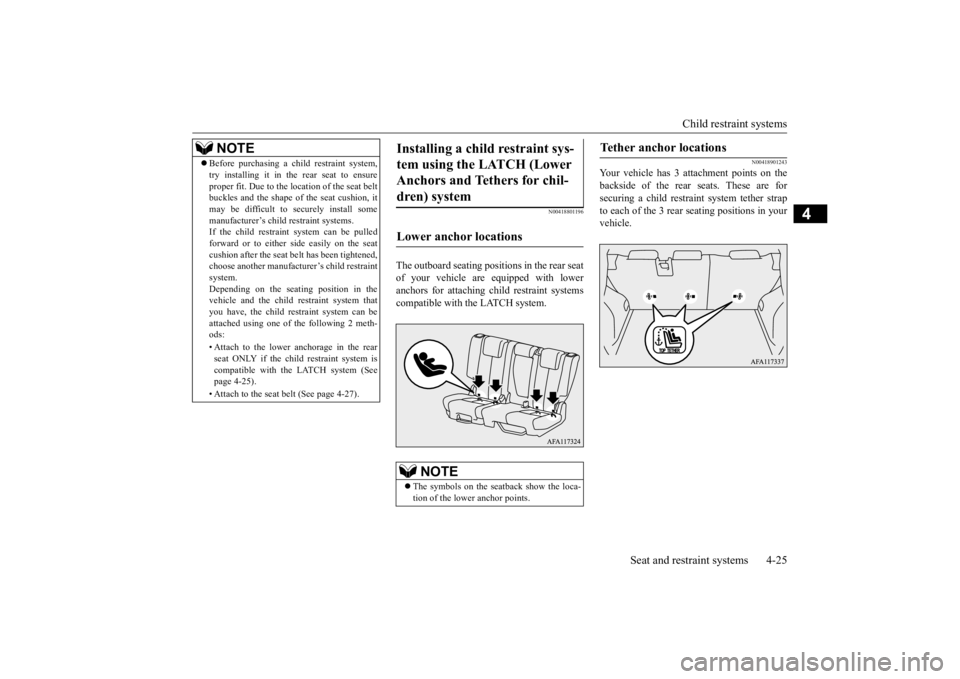
Child restraint systems
Seat and restraint systems 4-25
4
N00418801196
The outboard seating positions in the rear seat of your vehicle are equipped with loweranchors for attaching child restraint systemscompatible with the LATCH system.
N00418901243
Your vehicle has 3 attachment points on thebackside of the rear
seats. These are for
securing a child restraint system tether strap to each of the 3 rear seating positions in your vehicle.
NOTE
Before purchasing a child restraint system, try installing it in the rear seat to ensure proper fit. Due to the location of the seat belt buckles and the shape of the seat cushion, it may be difficult to securely install somemanufacturer’s child restraint systems. If the child restraint system can be pulled forward or to either side easily on the seatcushion after the seat belt has been tightened, choose another manufacturer’s child restraint system.Depending on the seating position in the vehicle and the child restraint system that you have, the child restraint system can beattached using one of the following 2 meth- ods: • Attach to the lower anchorage in the rear seat ONLY if the child restraint system is compatible with the LATCH system (Seepage 4-25). • Attach to the seat belt (See page 4-27).
Installing a child restraint sys- tem using the LATCH (Lower Anchors and Tethers for chil- dren) system Lower anchor locations
NOTE
The symbols on the seatback show the loca- tion of the lower anchor points.
Tether anchor locations
BK0277700US.bo
ok 25 ページ 2019年3月8日 金曜日 午前9時23分
Page 63 of 427

Child restraint systems 4-28 Seat and restraint systems
4
1. Remove the head restraint from the loca- tion in which you wish to install a child restraint system. Refer to “Head restraints” on page 4-9.2. Adjust the seat where the child restraint system will be installed to the most rear- ward position.3. Adjust the seatback of the seat where the child restraint system will be installed as follows.[For front passenger’s seat]Adjust the seatback angle to six steps rearward from the most upright position. Refer to “Front seats:
To adjust the seat-
backs” on page 4-5. [For rear seats] Adjust the seatback angle to four stepsrearward from the most upright position. Refer to “Rear seats: To adjust the seat- backs” on page 4-7.4. Place the child restraint system on the seat. 5. Route the seat belt through the childrestraint system according to the instruc- tions provided by the child restraint sys- tem’s manufacturer. Then insert the seatbelt latch plate into the buckle. Make sure you hear a “click” when you insert the latch plate into the buckle.
6. To activate the ALR child restraint instal- lation function, slow
ly pull the shoulder
part of the belt all the way out of theretractor until it stops. Then let the belt feed back into the retractor. 7. After the belt has retracted, tug on it.
If the belt is in the ALR function, you will not be able to pull it out. If the webbing can be pulled out from retractor, the ALR function has not been activated and youwill need to repeat steps 6 and 7. 8. After confirming that the belt is locked, grab the shoulder part of the belt near thebuckle and pull up to remove any slack from the lap part of the belt allowing the slack to feed into the retractor. Remember,if the lap belt portion is not tight, the childrestraint system will not be secure. It may help to put your weight on the child restraint system and/or push on its seat-back while pulling up on the belt (See illustration). 9. Push and pull the ch
ild restraint system in
all directions to check that it is installed securely.If the child restraint system is not installed securely, proceed to step 10.
BK0277700US.bo
ok 28 ページ 2019年3月8日 金曜日 午前9時23分
Page 64 of 427
![MITSUBISHI ECLIPSE CROSS 2020 Owners Manual (in English) Child restraint systems
Seat and restraint systems 4-29
4
10. [For front passenger’s seat]
Repeat steps 8 and 9. [For rear seats] Adjust the seatback angle forward untilthe child restraint system MITSUBISHI ECLIPSE CROSS 2020 Owners Manual (in English) Child restraint systems
Seat and restraint systems 4-29
4
10. [For front passenger’s seat]
Repeat steps 8 and 9. [For rear seats] Adjust the seatback angle forward untilthe child restraint system](/img/19/34871/w960_34871-63.png)
Child restraint systems
Seat and restraint systems 4-29
4
10. [For front passenger’s seat]
Repeat steps 8 and 9. [For rear seats] Adjust the seatback angle forward untilthe child restraint system is firmly secured, and then check that the seatback is locked in place. Then push and pull thechild restraint system in all directions to check that it is installed securely. If your child restraint system requires theuse of a tether strap, fasten the tether strapin accordance with the following step 11.
11. Latch the tether strap hook (A) of the
child restraint system to the tether anchorbar (B) and tighten the tether strap so it is securely fastened.
12. Before putting your child in the restraint,
push and pull the restraint in all directionsto be sure it is firmly secure. Do thisbefore each use. If the child restraint sys- tem is not firmly secure, repeat steps 4 through 11.
13. To remove a child restraint system from
the vehicle and deactivate the ALR mode, remove the child from the restraint.Unlatch the buckle. Then remove the belt from the restraint and let the belt fully retract.
14. Reinstall the head restraint.
Refer to “Head restraints” on page 4-9.
N00407601628
Children who have outgrown a child restraint system should be seated in the rear seat andwear the seat belt. If the shoulder belt crosses their face or neck, and/or the lap belt crosses their stomach, a commercially available
booster seat must be used to raise the child so that the shoulder belt crosses their shoulder and the lap belt remains positioned low across their hips. The booster seat should fitthe vehicle seat and have a label certifying compliance with Federal Motor Vehicle Safety Standards or Motor Vehicle RestraintSystems and Booster Seats Safety Regula- tions.
WA R N I N G Child restraint system tether anchors are designed only to withstand loads from cor- rectly fitted child restraint systems. Under no circumstances are they to be used for adult seat belts, harnesses, for attachingother items, or equipment to the vehicle.
Children who have outgrown child restraint systems
WA R N I N G Any child who is too small to properly wear a seat belt must be properly restrained in an appropriate child restraint system, to reduce their risk ofserious injury or death in an accident. A child should never be left unattended in, or unsupervised around, your vehicle. When you leave the vehicle, always take the child out as well. Children can die from he
at stroke if left or
trapped inside the vehicle, especially onhot days. Keep your vehicle locked when not in use. Keep your vehicle keys away from chil- dren.
BK0277700US.bo
ok 29 ページ 2019年3月8日 金曜日 午前9時23分
Page 65 of 427

Maintenance and inspection of seat belts 4-30 Seat and restraint systems
4
N00407001417
Regularly check your seat belt buckles and their release mechanisms for positive engage-ment and release of the latch plate. Check the retractors for automatic locking when in the Automatic Locking Retractor function. The entire seat belt assembly should be replaced if the webbing shows any obviouscuts, tears, increase in thickness in any sec- tion of the webbing from broken fibers, or severe fading from sunlight. All of these con-ditions indicate a weakening of the belt, which may adversely affect seat belt perfor- mance in an accident.
N00407701892
This vehicle is equipped with a SupplementalRestraint System (SRS), which includes air-bags for the driver and passengers. The SRS front airbags are designed to supple- ment the primary protection of the driver and front passenger seat belt systems by provid- ing those occupants with protection against
head and chest injuries in certain moderate to severe frontal collisions. The SRS front air- bags, together with sensors at the front of the vehicle and sensors attached to the frontseats, form an advanced airbag system. The SRS driver’s knee airbag is designed to supplement the primary protection of the driver’s seat belt system. It can reduce theforward movement of the driver’s lower legs and provide increased overall body protection in certain moderate to severe frontal colli-sions. The SRS side airbags and the curtain airbags are also designed to supplement the seat belts. The SRS side airbags provide the driver and front passenger with protection against chestinjuries by deploying the bag on the side impacted in moderate to severe side impact collisions. The SRS curtain airbags provide the driver and the passengers on the front seat and the rear outboard seats with protection against head injuries by deploying the curtain airbagon the side impacted in moderate to severe side impact collisions and by deploying both curtain airbags when a rollover is detected.The curtain airbags are also designed to help reduce the risk of complete and partial ejec- tion from the vehicle through side windows
Maintenance and inspection of seat belts
WA R N I N G Do not attempt to repair or replace any part of the seat belt assemblies. This work should be done by an authorizedMitsubishi Motors dealer. Failure to have an authorized Mitsubishi Motors dealer perform the work could reduce the effec- tiveness of the belts and could result in a serious injury or death in an accident.
Never use an organic solvent to clean the seat belt webbing. Do not attempt to bleach or re-dye the seat belt webbing. These may weaken the seat belt webbing, increasing risk of injury or death in anaccident. Clean seat belt webbing only with mild soap or detergent solution and rinse itwith lukewarm water, and dry the seat belt webbing completely before retracting it.
Supplemental Restraint Sys- tem (SRS) - airbag
NOTE
The SOS emergency assistance (if so equipped) is designed to operate when any of the airbags deploy or severe collision occurs. Refer to “Telematics Control Unit (TCU)” on page 3-5.WA R N I N G
BK0277700US.bo
ok 30 ページ 2019年3月8日 金曜日 午前9時23分